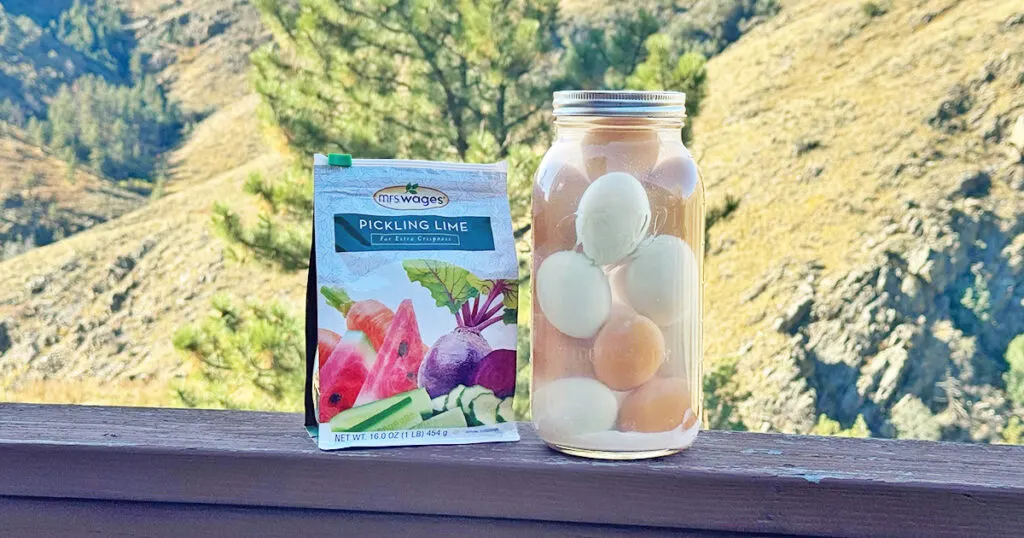In today’s fast-paced world, where convenience often trumps tradition, many age-old preservation techniques have been forgotten. However, with the rising interest in sustainable living and self-sufficiency, some of these methods are making a comeback. One such technique is “water glassing” eggs. This method has been used for centuries to preserve eggs for extended periods without refrigeration. Let’s delve into the how-to and the science behind this fascinating preservation method.

Get the Printable PDF:
You can purchase the PDF download for $5 here: https://shop.buckhorncliffs.com/products/water-glassing-eggs-a-long-term-preservation-method-digital-pdf-download
How to Water Glass Eggs:
Materials:
- 1/2 gallon canning jar
- 1 quart of water
- 1oz pickling lime (Calcium Hydroxide)
- Fresh, clean (unwashed) eggs: Only use eggs that have not been washed or rinsed with water. They must retain their natural bloom, a protective coating that seals the shell’s pores and prevents bacteria from entering.
Procedure:
- Begin by ensuring your canning jar is clean and free from any residues.
- In a separate container, mix the quart of water with the 1oz of pickling lime until dissolved (the pickling lime may not fully dissolve and that’s okay). This solution is your “water glass.”
- Carefully place your eggs in the canning jar, pointy side down. It’s crucial to ensure that the eggs are free from any cracks, even hairline ones. The integrity of the eggshell is vital for successful preservation.
- Pour the water glass solution over the eggs, ensuring they are fully submerged.
- Seal the jar and store it in a cool, dark location.
Usage:
- The eggs can be stored this way for up to 2 years.
- When you’re ready to use them, simply remove the desired amount of eggs from the jar.
- Rinse off the pickling lime thoroughly.
- Use the eggs as you would any fresh egg.
The Science Behind Water Glassing:
Water glassing eggs is a method that capitalizes on the alkaline environment created by the pickling lime solution. This environment is inhospitable to bacteria and other microorganisms that would typically cause the eggs to spoil.
Eggshells are porous, allowing for the exchange of gases. The pickling lime solution effectively seals these pores, reducing the amount of oxygen that can enter the egg. This, combined with the alkaline environment, ensures that the internal contents of the egg remain preserved.
By storing the eggs pointy side down, the air cell within the egg is positioned at the top, which helps in maintaining the egg’s freshness. This position keeps the yolk centered and prevents it from getting in contact with the air cell, which can cause the yolk to dry out or spoil.
Questions and Answers about Water Glassing Eggs
Does water glassing change the taste of the eggs? Water glassing primarily preserves the egg without significantly altering its taste. However, some individuals might notice a slight difference in flavor, especially if the eggs have been stored for an extended period.
How does the texture of the egg change, if at all, after being preserved using this method? The texture of the egg remains largely consistent, but over time, the white might become slightly more watery, and the yolk may become a bit firmer.
Can I use store-bought eggs for water glassing if they haven’t been washed? Yes, as long as the store-bought eggs haven’t been washed and the natural bloom is intact, they can be used for water glassing.
How can I ensure that the eggs I’m using haven’t been washed? The best way is to source eggs directly from a local farmer or raise your own chickens. If purchasing from a store, look for labels that specify the eggs are unwashed.
Is there a specific type of pickling lime that should be used for water glassing? Food-grade pickling lime is recommended for water glassing to ensure safety and effectiveness.
How do I know if an egg has a hairline crack before using it for this method? Submerge the egg in water. If it leaks or produces bubbles, it might have a crack. Visually inspecting under a light source can also help identify hairline cracks.
Can I use containers other than a 1/2 gallon wide mouth canning jar for water glassing? Yes, any clean, sterile container with a tight-sealing lid can be used, but it’s essential to ensure that the eggs are fully submerged in the solution.
How can I tell if an egg has gone bad after being preserved using water glassing? A bad egg will often have an unpleasant sulfuric smell. The float test, where a spoiled egg will float in water due to gas buildup, can also be an indicator.
Are there any risks or potential health concerns associated with this preservation method? As long as the instructions are followed correctly and the eggs are stored in a cool, dark place, the risks are minimal. However, always inspect and smell the egg before use.
How does the natural bloom on the egg contribute to the preservation process? The natural bloom is a protective layer that seals the egg’s pores, preventing bacteria and contaminants from entering. It plays a crucial role in the preservation process.
Can I use water glassing for other food items or is it specific to eggs? Water glassing is primarily used for eggs due to their porous nature and the protective bloom. It’s not commonly used for other food items.
How does the alkaline environment prevent the growth of bacteria and microorganisms? The alkaline environment created by the pickling lime solution is inhospitable to most bacteria and microorganisms, preventing them from multiplying and spoiling the egg.
Is there a limit to how many eggs can be preserved in a single jar using this method? The only limit is the size of the container. Ensure that all eggs are fully submerged in the solution and that there’s some space at the top of the jar.
How should the jar be sealed to ensure the best preservation? The jar should be sealed tightly to prevent any external contaminants from entering.
Can I use the eggs preserved by water glassing for all culinary purposes, like baking and frying? Yes, once rinsed and cleaned, the eggs can be used for various culinary purposes, just like fresh eggs.
Does the nutritional content of the egg change after being preserved using water glassing? The nutritional content remains largely unchanged, but there might be minor variations based on the duration of storage.
How do I properly rinse off the pickling lime from the eggs before use? Rinse the eggs under cold running water, gently scrubbing with your fingers to ensure all pickling lime residues are removed.
Can the water glass solution be reused for another batch of eggs? It’s best to prepare a fresh solution for each batch to ensure optimal preservation conditions.
What’s the science behind the eggshell’s porosity and its role in this preservation method? Eggshells are naturally porous, allowing for the exchange of gases. The pickling lime solution effectively seals these pores, reducing the amount of oxygen that can enter the egg, thereby preserving its contents.
Are there any regions or climates where water glassing is particularly effective or ineffective? Water glassing is effective in most regions and climates as long as the eggs are stored in a cool, dark place. However, in extremely humid conditions, there might be a slightly reduced shelf life.
In Conclusion:
Water glassing is a testament to the ingenuity of our ancestors. In a time without modern conveniences like refrigeration, they devised methods to ensure food security and reduce waste. By understanding and applying these techniques today, we not only connect with our past but also equip ourselves with valuable skills for a sustainable future. So, the next time you have a surplus of eggs, why not give water glassing a try? It’s a simple, effective, and eco-friendly way to preserve nature’s bounty.
